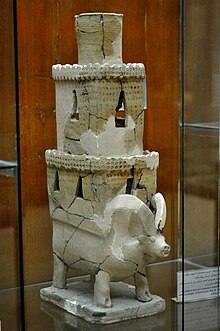
The Hurrian religion was the polytheistic religion of the Hurrians, a Bronze Age people of the Near East who chiefly inhabited the north of the Fertile Crescent. While the oldest evidence goes back to the third millennium BCE, it is best attested in cuneiform sources from the second millennium BCE written not only in the Hurrian language, but also Akkadian, Hittite and Ugaritic. It was shaped by contacts between the Hurrians and the various cultures with which they coexisted. As a result, the Hurrian pantheon included both natively Hurrian deities and those of foreign origin, adopted from Mesopotamian, Syrian (chiefly Eblaite and Ugaritic), Anatolian and Elamite beliefs. The culture of the Hurrians was not entirely homogeneous, and different local religious traditions are documented in sources from Hurrian kingdoms such as Arrapha, Kizzuwatna and Mitanni, as well as from cities with sizeable Hurrian populations, such as Ugarit and Alalakh.
Hurrian religion forms one of the best attested influences upon Hittite religion. The Hurrian pantheon is depicted in the rock reliefs from the Hittite sanctuary at Yazılıkaya, which dates to the thirteenth century BCE. Hittite scribes also translated many Hurrian myths into their own language, possibly relying on oral versions passed down by Hurrian singers. Among the best known of these compositions are the cycle of myths describing conflicts between Kumarbi and his son Teššub and the Song of Release. Hurrian influences on Ugaritic and Mesopotamian religion also have been noted, though they are less extensive. Furthermore, it has been argued that the Hurrian myths about a succession struggle between various primordial kings of the gods influenced Hesiod's poem Theogony.